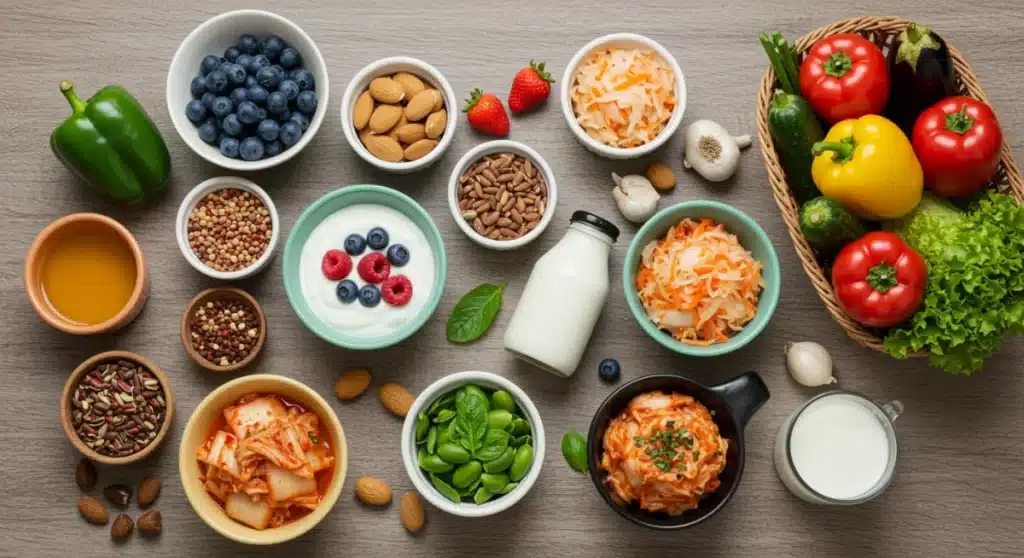Probiotic Foods: Your 2025 Guide to a Healthy Gut

Advertisement
Optimizing gut health in 2025 involves strategically incorporating a diverse range of probiotic-rich foods into your diet, leveraging their beneficial microorganisms to support digestion, immunity, and overall family well-being.
Welcome to The Ultimate Guide to Probiotic-Rich Foods for a Healthy Gut in 2025! In an era where wellness and preventive health are paramount, understanding the power of your gut microbiome has never been more critical. This guide will navigate you through the best probiotic sources, helping you and your family cultivate a thriving internal ecosystem for improved health and vitality.
understanding the gut microbiome’s importance
Before diving into specific foods, it’s essential to grasp why your gut microbiome matters so much. This vast community of microorganisms living in your digestive tract plays an integral role in nearly every aspect of your health, from digestion and nutrient absorption to immune function and even mood regulation.
Advertisement
A balanced microbiome, rich in beneficial bacteria, acts as a protective barrier against pathogens, synthesizes crucial vitamins, and helps maintain a healthy weight. When this delicate balance is disrupted, it can lead to various health issues, including digestive discomfort, weakened immunity, and increased susceptibility to chronic diseases. Nurturing your gut is a foundational step toward overall well-being for every family member.
the role of probiotics in gut health
Probiotics are live microorganisms that, when administered in adequate amounts, confer a health benefit on the host. Essentially, they are the ‘good’ bacteria that help restore and maintain a healthy balance in your gut. Think of them as tiny allies working tirelessly to keep your digestive system running smoothly.
- Digestive Support: Probiotics aid in breaking down food and absorbing nutrients more efficiently, reducing issues like bloating and constipation.
- Immune Boost: A significant portion of your immune system resides in your gut, and probiotics help strengthen its defenses against illness.
- Mood Regulation: Emerging research suggests a strong link between gut health and mental well-being, with probiotics potentially influencing mood and cognitive function.
- Inflammation Reduction: Certain probiotic strains have anti-inflammatory properties, which can be beneficial for various health conditions.
Understanding these fundamental roles highlights why incorporating probiotic-rich foods 2025 into your diet is not just a trend but a vital health strategy. It’s about proactively supporting your body’s natural processes and building resilience from within. This holistic approach benefits everyone, from toddlers to grandparents, ensuring a foundation of robust health for the entire family.
Advertisement
fermented dairy delights: yogurt and kefir
When most people think of probiotic foods, yogurt often comes to mind first, and for good reason. Yogurt and kefir are staples in many diets, offering a delicious and accessible way to introduce beneficial bacteria into your system. These fermented dairy products are made by adding specific bacterial cultures to milk, which then consume the milk’s sugars and produce lactic acid, giving them their characteristic tangy flavor and creamy texture.
The fermentation process not only creates probiotics but also makes the dairy easier to digest for some individuals who are lactose sensitive. Choosing the right yogurt or kefir is key; look for labels that explicitly state ‘live and active cultures’ and ideally avoid products loaded with excessive sugars or artificial additives. Opt for plain varieties and sweeten them naturally with fruit or a touch of honey.
yogurt: a versatile probiotic source
Yogurt is incredibly versatile, making it easy to incorporate into breakfast, snacks, or even savory dishes. Its creamy texture makes it appealing to children, and with various flavors and styles available, there’s usually a type to suit every palate.
- Greek Yogurt: Higher in protein, offering a thicker consistency and often more concentrated probiotics.
- Traditional Yogurt: A classic choice, providing a good source of calcium and beneficial bacteria.
- Non-Dairy Options: For those avoiding dairy, coconut, almond, or soy yogurts with added live cultures are excellent alternatives.
Remember that not all yogurts are created equal in terms of probiotic content. Always check the ingredient list for specific strains like Lactobacillus and Bifidobacterium, which are common and well-researched beneficial bacteria. Integrating yogurt into your family’s routine can be a simple yet effective step towards better gut health.
kefir: the potent probiotic drink
Kefir, often described as a drinkable yogurt, is even more potent in terms of probiotic diversity. It’s fermented with kefir grains, which are a symbiotic culture of bacteria and yeasts (SCOBY), resulting in a wider array of beneficial microorganisms than most yogurts. Kefir has a slightly tart, fizzy taste and a thinner consistency, making it ideal for smoothies or drinking on its own.
The unique fermentation process of kefir creates a product rich in various strains of probiotics, as well as vitamins and minerals like calcium, magnesium, and B vitamins. Its robust probiotic profile makes it an excellent choice for those looking to significantly boost their gut flora. Many families find it an easy addition to morning routines, blended with fruits for a nutritious and gut-friendly breakfast.
fermented vegetables: kimchi and sauerkraut
Beyond dairy, fermented vegetables offer another powerful avenue for enhancing gut health. Kimchi and sauerkraut, in particular, are celebrated for their rich probiotic content and distinct flavors. These foods are created through lacto-fermentation, a process where beneficial bacteria convert sugars in vegetables into lactic acid, preserving them and creating a host of probiotics.
The fermentation process not only boosts their probiotic levels but also enhances their nutrient bioavailability and adds complex flavors that can elevate any meal. Incorporating these tangy additions into your diet provides a fantastic way to diversify your gut microbiome, which is crucial for comprehensive health benefits. For families, introducing these unique flavors can be an exciting culinary adventure.
kimchi: the korean superfood
Kimchi, a traditional Korean side dish made from fermented cabbage and other vegetables with a spicy seasoning, is a true superfood for your gut. Its vibrant flavor and impressive probiotic profile have earned it global recognition. The fermentation of kimchi introduces a wide variety of beneficial lactic acid bacteria, including various strains of Lactobacillus.
- Nutrient Powerhouse: Rich in vitamins A, B, and C, as well as minerals like calcium and iron.
- Immune Support: The diverse bacterial strains in kimchi contribute to a stronger immune system.
- Antioxidant Properties: The ingredients in kimchi, like garlic and chili peppers, are packed with antioxidants.
Kimchi can be enjoyed as a side dish, mixed into rice, soups, or even in sandwiches. Its pungent and spicy notes might be an acquired taste for some, but its health benefits make it worth exploring. When selecting kimchi, look for traditionally fermented varieties found in the refrigerated section of your grocery store, as pasteurized versions may have fewer live probiotics.

sauerkraut: a european classic
Sauerkraut, meaning ‘sour cabbage’ in German, is another excellent source of probiotics, created by fermenting finely shredded cabbage. It’s a simple yet incredibly effective way to support your gut. Like kimchi, traditional sauerkraut is made through lacto-fermentation, producing beneficial bacteria and enhancing its nutritional value.
Beyond its probiotic content, sauerkraut is also a good source of fiber, vitamin C, and vitamin K. Its tangy, slightly salty flavor pairs well with various dishes, from hot dogs and sandwiches to salads and roasted vegetables. For optimal probiotic benefits, ensure you choose raw, unpasteurized sauerkraut, typically found in the refrigerated section of health food stores or specialty markets. Making your own sauerkraut at home is also a rewarding and cost-effective option.
Both kimchi and sauerkraut demonstrate that not all probiotic foods need to be dairy-based. They offer robust alternatives for those with dairy sensitivities or who simply wish to diversify their probiotic intake. Integrating these fermented vegetables into your diet provides a powerful boost to your gut microbiome, contributing to a healthier digestive system and overall well-being for the entire family.
beyond the basics: kombucha and other fermented drinks
While yogurt, kefir, kimchi, and sauerkraut are well-known, the world of probiotic-rich foods extends much further, particularly into the realm of fermented beverages. Kombucha has surged in popularity, but other less common yet equally beneficial drinks also deserve attention. These fermented liquid options provide a refreshing and enjoyable way to introduce diverse probiotic strains into your diet, often with unique flavor profiles.
The convenience of these drinks makes them an easy addition to busy lifestyles, offering a quick probiotic boost on the go. For families, they can be a healthier alternative to sugary sodas, providing both hydration and gut-friendly benefits. Exploring these beverages can add exciting variety to your routine, ensuring a broader spectrum of beneficial bacteria for optimal gut health.
kombucha: the fizzy tea elixir
Kombucha, a fermented tea, has become a household name in the health and wellness community. Made by fermenting sweetened tea with a SCOBY (Symbiotic Culture of Bacteria and Yeast), kombucha results in a slightly effervescent, tangy, and often fruity drink. The fermentation process produces a range of beneficial bacteria, organic acids, and antioxidants.
- Digestive Aid: The organic acids and probiotics in kombucha can assist with digestion and nutrient absorption.
- Detoxification Support: Some research suggests kombucha may support liver function and detoxification processes.
- Antioxidant Boost: Rich in polyphenols from tea, kombucha offers antioxidant protection.
When choosing kombucha, be mindful of sugar content, as some commercial brands can be quite high. Look for brands with lower sugar per serving or consider brewing your own at home to control ingredients. It’s a delightful way to diversify your intake of probiotic-rich foods 2025 and keep your gut happy.
miso and tempeh: soy-based ferments
For those seeking non-dairy and non-vegetable fermented options, miso and tempeh are excellent choices. Miso is a traditional Japanese seasoning made from fermented soybeans, often with rice or barley. It’s a rich source of beneficial bacteria and has a savory, umami flavor that adds depth to soups, dressings, and marinades.
Tempeh, an Indonesian staple, is made from fermented whole soybeans formed into a firm, cake-like block. The fermentation process makes the soybeans more digestible and increases their nutrient content. Tempeh is an excellent source of protein, fiber, and probiotics, making it a versatile meat alternative that can be grilled, baked, or crumbled into dishes. Both miso and tempeh offer unique probiotic strains and a wealth of nutrients, making them valuable additions to a gut-healthy diet.
sourdough and other grain-based ferments
The benefits of fermentation extend beyond dairy and vegetables to grains, offering another delicious category of probiotic-rich foods. Sourdough bread, in particular, stands out as a traditional fermented grain product that can contribute positively to gut health. Unlike conventional bread, sourdough relies on a ‘starter’ – a symbiotic culture of wild yeasts and lactic acid bacteria – to leaven the dough.
This slow fermentation process breaks down complex carbohydrates and proteins in the flour, making sourdough bread easier to digest for many people. It also reduces the phytic acid content, which can inhibit mineral absorption, thereby increasing the bioavailability of nutrients. For families, sourdough can be a more gut-friendly alternative to regular bread, offering both flavor and digestive benefits.
the magic of sourdough bread
Sourdough bread is more than just a tasty loaf; it’s a testament to ancient fermentation practices that enhance nutrition and digestibility. The lactic acid bacteria in sourdough contribute to its characteristic tangy flavor and can produce beneficial compounds. While the baking process significantly reduces the number of live probiotics, the fermentation still renders the bread more digestible and nutrient-rich.
- Improved Digestibility: The fermentation breaks down gluten and fructans, which can be problematic for some individuals.
- Enhanced Nutrient Absorption: Reduced phytic acid allows for better absorption of minerals like iron and zinc.
- Lower Glycemic Index: Sourdough often has a lower glycemic index compared to conventional bread, leading to more stable blood sugar levels.
When choosing sourdough, look for loaves made with traditional, long fermentation processes, often found at artisan bakeries. These are more likely to offer the digestive benefits associated with true sourdough. Baking your own sourdough can also be a rewarding project, allowing you to control the ingredients and process entirely.
rejuvelac and fermented oats
Beyond sourdough, other grain-based ferments provide unique probiotic benefits. Rejuvelac is a fermented grain drink, typically made from sprouted wheat berries, that is rich in enzymes and beneficial bacteria. It has a mild, tangy flavor and can be consumed on its own or used as a base for raw food recipes.
Fermented oats, while less common commercially, can also be prepared at home. Soaking and fermenting oats with a starter culture or a touch of kefir can enhance their digestibility and increase their probiotic content. This makes oatmeal an even more powerful breakfast option, particularly beneficial for individuals seeking diverse sources of probiotics beyond dairy. These grain-based ferments highlight the versatility of traditional food preparation methods in promoting gut health.
prebiotics: the fuel for probiotics
While focusing on probiotic-rich foods 2025 is crucial, it’s equally important to understand the role of prebiotics. Prebiotics are non-digestible food components that selectively stimulate the growth and activity of beneficial bacteria in the gut. Think of them as the food that helps your probiotics thrive and multiply. Without adequate prebiotics, even the best probiotic intake might not yield optimal results.
Including a variety of prebiotic-rich foods in your diet creates a synergistic effect, maximizing the benefits of the probiotics you consume. This dual approach ensures a robust and diverse gut microbiome, which is the cornerstone of excellent digestive health and overall well-being for the entire family. Balancing both prebiotics and probiotics is key to a truly healthy gut.
top prebiotic food sources
Nature provides an abundance of foods rich in prebiotics, making it easy to incorporate them into your daily meals. Many common fruits, vegetables, and grains are excellent sources, contributing to a balanced diet and a flourishing gut environment.
- Garlic and Onions: These kitchen staples contain fructans and inulin, powerful prebiotics that support beneficial bacteria.
- Leeks and Asparagus: Rich in inulin, these vegetables foster the growth of Bifidobacteria, a key probiotic strain.
- Bananas: Especially slightly underripe ones, contain resistant starch that acts as a prebiotic.
- Oats and Barley: Whole grains like these provide beta-glucans and other fibers that feed good gut bacteria.
- Apples: Pectin in apples is a fantastic prebiotic, supporting a healthy gut lining.
By consciously including these foods alongside your probiotic sources, you create an optimal environment for your gut flora to flourish. This not only enhances digestion but also contributes to better nutrient absorption and a stronger immune system. Making these dietary choices benefits everyone at home, from picky eaters to adults, by naturally supporting their digestive health.
the synergy of prebiotics and probiotics
The concept of synbiotics refers to foods or supplements that combine both prebiotics and probiotics, offering a powerful one-two punch for gut health. While some foods naturally contain both, consciously pairing them in your meals can amplify their benefits. For instance, enjoying yogurt with a banana or adding garlic to your kimchi can create a synergistic effect.
This combined approach ensures that you’re not only introducing beneficial bacteria but also providing them with the necessary fuel to survive and thrive. A diverse diet rich in both prebiotics and probiotic-rich foods 2025 is the most effective strategy for maintaining a balanced and healthy gut microbiome. It’s a sustainable way to support long-term digestive and overall health for every member of your family.
integrating probiotics into your family’s diet
Making significant dietary changes can be challenging, especially when feeding a family with varied tastes and preferences. However, integrating probiotic-rich foods into your family’s diet doesn’t have to be daunting. The key is to start small, be creative, and make it a gradual, enjoyable process. The goal is to make gut-healthy eating a natural part of your family’s lifestyle.
Remember that consistency is more important than perfection. Even small, regular additions of fermented foods can make a big difference over time in supporting a healthy gut microbiome for everyone from toddlers to adults. This section offers practical tips to help you successfully introduce these beneficial foods and make them a welcome part of your family’s daily meals.
tips for success with children
Children can be notoriously picky eaters, but with a bit of creativity, you can introduce probiotic foods in ways they’ll enjoy. Start with milder flavors and gradually introduce new ones. The goal is to make it fun and palatable, not a chore.
- Smoothie Power: Blend plain kefir or yogurt with their favorite fruits for a delicious and stealthy probiotic boost.
- Hidden Goodness: Mix a spoonful of sauerkraut (finely chopped) into mashed potatoes or a savory stew; its flavor can be masked by other ingredients.
- Kid-Friendly Ferments: Offer small portions of mild fermented pickles or naturally fermented fruit purees.
- Lead by Example: Children are more likely to try new foods if they see their parents enjoying them.
Focus on making it a positive experience, celebrating small victories, and not forcing the issue. Over time, their palates will adapt, and they might even begin to enjoy the unique flavors of fermented foods. Introducing these habits early can set them up for a lifetime of better gut health.
meal planning and preparation ideas
Incorporating probiotic-rich foods 2025 into your family’s meal plan can be simple with a little foresight. Think about where you can naturally add fermented items without overhauling entire recipes. This approach makes integration seamless and less intimidating for busy parents.

For breakfast, serve yogurt or kefir with granola and berries. At lunch, add a side of sauerkraut or kimchi to sandwiches or salads. Dinner can feature miso soup, tempeh stir-fries, or even a dollop of sour cream (a fermented dairy product) on top of chili or baked potatoes. Even snacks can be gut-friendly; consider a small bowl of plain yogurt with fruit or a glass of kombucha.
Batch cooking fermented items like sauerkraut or making a large batch of homemade yogurt can save time during the week. Experiment with various recipes and find what your family enjoys most. The more diverse your intake of fermented foods, the broader the range of beneficial bacteria you’ll introduce into your gut, leading to more comprehensive health benefits for everyone.
| Key Probiotic Food | Brief Description & Benefits |
|---|---|
| Yogurt & Kefir | Fermented dairy, rich in diverse live cultures for digestion and immune support. Look for ‘live active cultures’. |
| Kimchi & Sauerkraut | Lacto-fermented vegetables, offering diverse bacterial strains, vitamins, and enhanced flavor. Choose unpasteurized. |
| Kombucha | Fizzy fermented tea with beneficial bacteria, organic acids, and antioxidants; supports digestion. |
| Sourdough & Prebiotics | Sourdough offers easier digestion. Prebiotics (garlic, oats) feed probiotics, boosting gut flora. |
frequently asked questions about probiotic foods
Probiotics are live microorganisms, primarily bacteria, that provide health benefits when consumed. They are crucial for maintaining a balanced gut microbiome, aiding digestion, boosting the immune system, and potentially influencing mood and overall well-being. A healthy gut is foundational for good health.
Not all fermented foods contain live and active probiotic cultures. For a food to be considered probiotic-rich, it must contain specific beneficial bacteria in sufficient quantities. Processing like pasteurization can kill these beneficial organisms. Always check labels for ‘live and active cultures’ when buying fermented products.
Start with milder options like plain yogurt or kefir blended into smoothies with their favorite fruits. You can also try finely chopping sauerkraut and mixing it into familiar dishes like mashed potatoes or stews. Gradual introduction and leading by example often work best.
Probiotics are live beneficial bacteria that you consume, while prebiotics are non-digestible fibers that act as food for these probiotics. Both are essential for a healthy gut. Prebiotics help probiotics thrive and multiply, creating a synergistic effect for optimal gut health.
While probiotic supplements can be beneficial, they generally shouldn’t replace a diet rich in probiotic foods. Foods offer a wider diversity of strains, along with other essential nutrients and fiber. Supplements can complement a healthy diet but are usually not a standalone solution for comprehensive gut health.
conclusion
Embracing probiotic-rich foods 2025 is a powerful and delicious strategy for cultivating a healthy gut and enhancing overall family well-being. From the creamy goodness of yogurt and kefir to the tangy crunch of kimchi and sauerkraut, and the refreshing fizz of kombucha, the options are diverse and readily available. By understanding the vital role of the gut microbiome and consciously integrating these beneficial foods, along with their prebiotic fuel, you embark on a journey toward improved digestion, stronger immunity, and a more vibrant life for everyone in your household. Make gut health a priority, and watch your family thrive.





